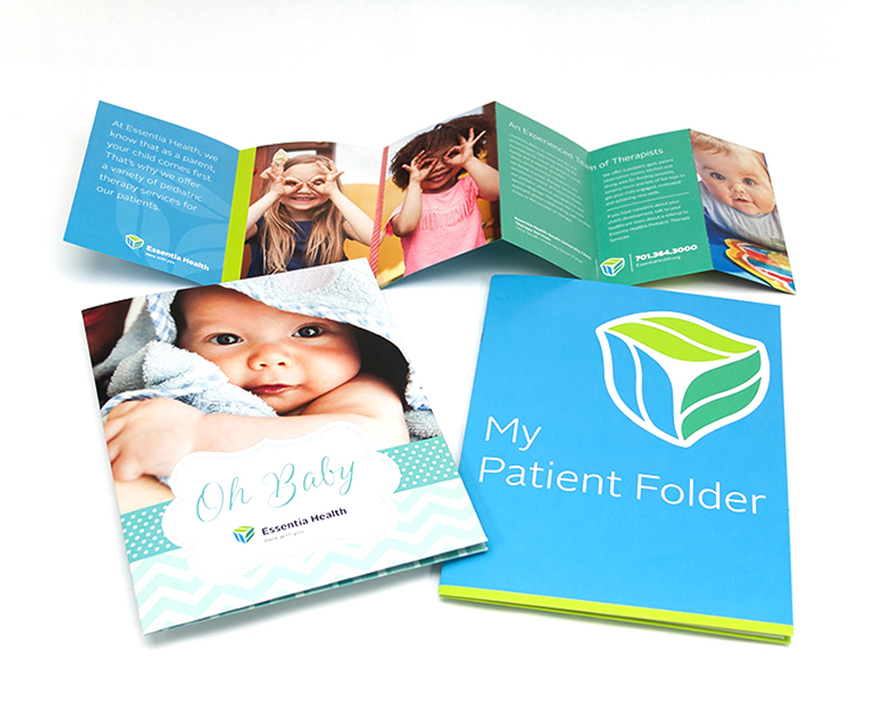 There are two very basic reasons why you might desire a coating on your printed piece, protection and visual appearance.
There are two very basic reasons why you might desire a coating on your printed piece, protection and visual appearance.
- Protection: Coatings are used to help preserve the inks that are printed. A “flood” of coating (covering the entire surface) is a way to protect your materials. Coatings help reduce fingerprints, rub off and scratching. If your piece will be handled again and again, such as pocket folders, a coating will keep them looking fresh and new longer! Some ink take longer to dry than others. Certain coatings will speed the drying process and expedite your printed piece through the bindery processes without smearing or offsetting.
- Visual Appearance: If you want all or part of your design to really stand out, a coating will do that for you. Coatings enhance colors and can be shiny or dull, and are a great tool for showing off photography and illustrations. Using a combination of dull and glossy can create a visually appealing effect!
There are many types of coatings. Here is some basic information about coatings.
- Varnish: Varnish comes in gloss and dull finishes and is the most economical of the coatings. You can “spot” or “flood” varnish your materials. Varnishes are applied on press like any other ink and can be tinted to create a special effect. Although gloss and dull varnishes are typically used as spot or overall coatings, they can also be incorporated in the process of spot color inks in order to provide a unique look to your piece.
- Aqueous: Aqueous coating is a water-based sealant and is applied “in-line” (on the press), and comes in gloss or dull. Aqueous is typically used for flooding the piece, and provides protection against rubbing. It can be used sparingly with spot areas, but it requires expensive blankets that have to be cut in a special way before it is run on press. Aqueous coatings are clear and prevent yellow with age. Another benefit of Aqueous is how quickly it dries, allowing for quicker printing the backside of the sheet. It is also more environmentally friendly because it is water-based.
- Strike Thru Coating: Strike Thru coating is an option that combines varnish and aqueous, and can produce two different effects.
- Flood Gloss: Aqueous with Spot Dull Varnish
- Flood Dull: Aqueous with Spot Gloss Varnish
Strike through can be explained like this – a spot dull strike thru over negative space with a flood gloss aqueous in-line – the strike thru dull varnish rises to the surface in the negative space and the gloss images are formed by the gloss aqueous. The advantages are you get a double coating (protection) and a good contrast effect. This is a great benefit for long runs with no budget for multiple passes.
- Soft Touch: A proprietary coating that is applied with a special metering roller to create a suede-like texture and extreme matte appearance.
- UV: UV coatings are applied after the piece is printed, and have the appearance of high gloss or almost a plastic-like appearance. The process involves spreading the clear liquid over the paper where it is instantly cured with ultraviolet light. It is most commonly used as a flood, and provides an extremely protective surface. These are also available in a dull coating.
Coatings have varying degrees of visual impact depending on coated stock vs. uncoated stock. Coated stocks produce the best results.
Some things to remember when designing you printed piece are:
- Coatings have impact on gluing process, as your piece needs to compensate for this to allow for adhesiveness.
- Coatings need to be knocked out for ink jetting so the ink will adhere to the paper.
At Knight Printing, we have many examples of different coatings for you to see and feel to help you decide what’s best for your project.
Glossary:
- Flood Coat: A coating that covers the entire surface of a printed piece.
- Spot Coat: A coating that is applied to specific areas of a sheet.
- In-line: An operation that completes any printing process in one pass, such as printing, varnishing folding, gluing etc.
- Knock out: An area of the sheet being printed that requires the absence of ink or any coating. Ink jetting, gluing, etc.
- Blanket: A fabric-reinforced sheet of rubber used on offset presses to transfer the impression from the plate to the paper.
- Plate: A flexible sheet of aluminum, plastic or rubber that carries an image to be reproduced by an offset press.
- Backup: Printing the backside of the sheet.
Knight Printing has been producing the highest quality printing in the region for nearly 130 years. We have the expertise and knowledge to bring your business and brand to life. If you want to leave a lasting impression with your customers, our team can guide you in new and exciting ways. Learn more about Knight Printing at knightprinting.com

